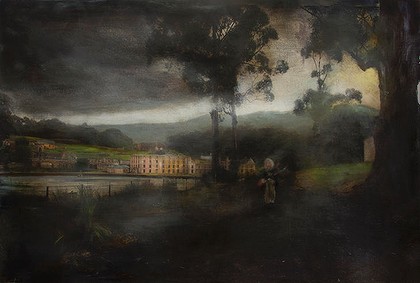Rodney Pople’s win of the Glover Prize for Landscape Painting has exposed some glaring contradictions in the art world, argues Carrie Miller…
The latest art ‘controversy’ in the mainstream media erupted a couple of days ago over this year’s winning entry in Australia’s richest landscape painting award, Tasmania’s Glover Prize.
Rodney Pople bagged the $35,000 with a picture of Port Arthur that included the figure of mass murderer Martin Bryant, assault rifle in hand.
The fact that Bryant has been represented at all has caused significant upset in the community most affected by the crime. Both the artist and the judges have defended the work on its artistic merits, emphasising the sensitive treatment of its subject matter. The chief judge, Doug Hall, made the point that Pople’s painting was not gratuitous:
“It is a very thoughtful poetical work about two moments in Port Arthur’s history and he has tried to bring these together in a deeply felt way,” Hall said.
Pople also made the point that the picture in no way glorifies Bryant: “Martin Bryant is not glorified in the painting he is very small and he’s in there because he is part of the framework and footprint of the landscape but only in a very small scale. He is sort of fading into the distance compared to the power of the whole landscape but he is part of it. I am not in any way glorifying Martin Bryant but to ignore it is looking in the wrong way as well.”
Pople then went further when questioned by the media, offering what can only be described as a moral defence of his work, claiming art like his serves a higher purpose by raising issues that are sometimes uncomfortable but nonetheless important for society to reflect on.
Many in the art world have rushed to Pople’s defence on the same basis. As so often happens when ‘controversy’ arises over an art work, wholesale defenders of Pople’s painting, including the artist himself, have missed the point. Of course, Martin Bryant is an integral part of the cultural landscape of Port Arthur. And, of course, representations of that landscape may figure him. That’s hardly a controversial idea. But the way images are read is contextual. And the meanings of those images aren’t reducible to the original intention of their producer – in this case, the artist.
For those people who feel affected by Martin Bryant’s crimes, the painting may never read as the artist intended it to. Or, for some, it may read in more than one way – both as an honest and sensitive depiction of the Port Arthur landscape and as a painful reminder of the past. It may simply read as good or bad art. Whatever ways it’s interpreted, to simply dismiss the concerns of people whose readings of it are narrowly shaped by the significant trauma caused by violent crime is deeply insensitive (In response to commentators calling for him to donate his prize money to a charity supporting victims, Pople was quoted as saying, “it’s none of their business, they’ve got their heads in the sand”, calling the idea “ridiculous”).
Moreover, Pople’s belief about the function of his work as a vehicle for debate involves a category mistake in the case of his Port Arthur painting. When justifying the often ‘controversial’ nature of his work, he claims art should not shy away from subjects that people want “swept under the carpet”. But an episode of mass murder by a mentally ill person acting alone which traumatised people don’t want to relive is in no way equivalent to, say, our persistent denial of the murder of indigenous people by colonisers – a good example of where art that deals with historical events has exposed inconvenient truths and has substantially contributed to the public conversation.
Pople claims to want to provoke debate by getting art on the front page. The obvious debate this ‘controversy’ should stimulate is one around art and censorship. As distasteful as Pople’s image is to those directly and indirectly affected by Martin Bryant’s crimes, supporters of the arts should take the opportunity his painting’s win provides to promote the idea that censorship is an unproductive way of dealing with the plurality of meanings that images produce. The way to do this is not by bullying people into submitting to the elitist idea that ‘good’ art is inherently worthy, but by ethically engaging those people who are genuinely offended by an art work, which is clearly the case here. There may even be a case for negotiation, for thinking about the contexts in which it’s displayed, how the image is reproduced and so on. There are many instances in art where sensitivity is shown on cultural grounds. Perhaps this is one. Perhaps not.
Maybe then we’ll get to a place where one day the only ‘controversy’ the media will ever report on in relation to art – the truly shocking thing about it – is how frequently mediocrity rises to the top.



This seems to me to be a story of insecure people grappling for attention. I hate when artists and curators do that!
I agree Teo, deliberately courting controversy just for the sake of it comes across poorly. If he has an intelligent discussion to offer then that is different.
We can’t control how every person reads work, there is always a risk that particular groups might find certain works painful. I don’t believe censorship is the answer but it is amazing how far a little tact will go.
Agreed, courting controversy like this to win a painting prize is not only cynical opportunism, it’s just plain lazy. It’s the art world’s equivalent of radio shock-jocks…which unfortunately, keeps getting defended, promoted and awarded by judges and curators.
It’s not far to look for the reasons why mediocrity so often floats to the top.
I think you’re spot on about a misplaced controversy. Bryant’s case seemed to be a story about how a kid with seriously violent tendencies slipped through the mental health system, rather than violence of the Tasmanian landscape. Robert Wainwright’s book (I only read the Spectrum review tho) told a really sad story of social services being unable to handle a man who had dangerous psychological problems as well as substantial personal wealth. He was identified as a kid with cruel and violent tendencies, but he fell out of the view of case workers when he fell into money. Combined with poor gun regulation at the time, something happened that could possibly be prevented in the future. So violence in the Tasmanian landscape? Bryant doesn’t seem like a good cypher for that at all, unless it is simply about a white guy with a gun, but that seems an oblique reference considering the possible interpretations by survivors and victims’ relatives. And what would that mean anyway? That Bryant is Mr and Mrs Andrews, the psychotic colonists? Seems a stretch. As you point out Carrie, the theft of land and massacres of indigenous people and are more related to the colonial picturesque composition Pople has quoted. The latest sickening part of Bryant’s story now is the U.S. based conspiracy theory that it was orchestrated by the government to take away people’s gun ownership rights.
The truth is, there was little controversy about the award before the local Hobart paper decided to make it into one. The reception in the conservative community of Evandale, where the prize is held, was positive. The judges did not choose it to deliberately cause controversy. They picked it because it stood out as a good painting. I wrote about the Mercury’s framing of this story last night: http://hobartart.blogspot.com.au/2012/03/glover-prize-mercury-and-massive-beat.html
The calls for the artist to donate his prize winnings came after they’d misrepresented the painting and intention of the artist. The Mercury spoke to the judges at length, but then gave column space to opponents of the work, rather than supporters.
I live in Hobart, and I know people who were directly affected that day and I’m sorry if they’re upset about the painting. However, I don’t believe the artist or the judges were out to deliberately harm the community. We need to stop pretending that Port Arthur’s bloody past is restricted to the now romanticised convict era.
[…] If he was a better painter, he would not need to include a figure of a moronic, psychopathic mass murderer. I don’t think it was necessary to ‘pop’ a figure of Bryant into this ‘painting’ to get a feeling about Port Arthur. We already know how we feel. And the idea of ‘Gothic Tasmania’ has been done to death, especially by people who don’t live here. The essence of Glover is the clear light. The essence of gothic & neogothic architecture is light and spirituallity… but that is another discussion all together.